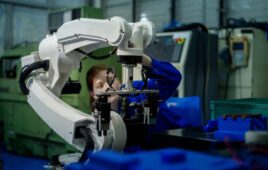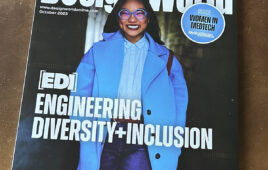Stephanie Moscrip
VP of Engineering Excellence and Linux
BSc Electrical Engineering, Queen’s University

Stephanie graduated from Queen’s University in Canada with a degree in electrical engineering with a computer option. Her career started at an optical devices and module company called JDS, which then became JDS Uniphase. For the first few years she worked in embedded software development, and then she transitioned into project management and general leadership roles. After more than 13 years, though, it was time for a change.
She took a short break when her kids were born, and then moved to Wind River, where she has happily worked for more than 14 years. She started as a project manager for the Wind River Linux project, working her way up to project director and working on most Wind River products in some capacity over the years. She transitioned to director of Linux Engineering in 2018, adding responsibilities for Engineering Excellence in 2020 and being promoted to VP of Engineering Excellence and Linux in 2021. She recently took on an additional role as VP of Strategic Initiatives, working to ensure execution of our strategic programs.
Talk about the culture at your company. What makes it inclusive or supportive of women in engineering and automation?
The word that first comes to mind when I’m asked to describe the culture at Wind River is family. Wind River is a place where people work for decades because we are passionate about our products, we support each other, we pull together to make things happen, and we have fun.
The second word that comes to mind is diverse. People at Wind River strongly believe that the best workforce is a diverse workforce, where different perspectives combine to bring out the best in everyone and everything we do. Wind River hosts a series of diversity and inclusion panels, one of which is geared toward women. It provides a great opportunity to learn about the careers and perspectives of other women in the company and is a must-attend for me personally.
The last word that comes to mind is balance. Wind River encourages and supports a balanced life — something I have appreciated, having raised now-16-year-old twins during the time I have been at Wind River.
Describe a recent company project in which you were involved that went particularly well.
I am thrilled to have been part of the Wind River Studio product creation over the last few years. What began as an inkling in someone’s mind is now a product that is going to enable a software-defined, AI-driven world. Bringing it to fruition in less than three years has been an incredible ride. As VP of Engineering Excellence, I was actively involved in working across the department to manage and enable our engineers to deliver as they grew from a team of ten to a team of hundreds. As VP of Strategic Programs, I am working with our partners and customers to further enable the vision. To see this product and vision gain traction across the industry and know that I was part of making it happen is incredibly satisfying.
How did you and your team go about ensuring success?
It took passion coupled with a growth mindset, alignment to a common vision, leaning in to support each other in meeting the common goal, and continuously improving step-by-step.
What first drew you to engineering and this industry?
In high school, I was very good at math and physics, and with an engineer as a father it seemed like a slam dunk to go into engineering. It is a decision I have never regretted. I started in electrical engineering but with a computer science elective, and it was software development that really got me excited. When I graduated, I got a job writing assembly and C code for embedded software in optical modules, and I loved every minute of it. I have been working in the embedded software industry ever since.
Describe your biggest career challenge. How did you solve it — or what was the outcome or lesson learned?
My biggest career challenge was being asked to take over our Wind River Linux product engineering team. Over time my career had shifted from doing software development myself to program management, where I had a natural aptitude. In my mind, taking on the Director of Linux Engineering role was a big leap over a huge chasm, and I am afraid of heights!
However, it ended up being one of the best decisions of my life. I realized a lot about my strengths and how they can be applied in different areas, and I was able to drive several strategic initiatives within the team. The one I am most proud of is transforming the team into a CI/CD organization. This required first that I get buy-in from the extended team and management, then work through the unique hurdles of doing CI/CD with an open source–based product. The team was creative and passionate and, in the end, we were able to complete the transformation within a year, becoming one of the first CI/CD organizations within the company and having the first Linux CI/CD offering in the industry. Lesson learned: Take the leap.
What career advice would you give to your younger self?
I would tell myself to have more confidence in my skill set. I would say, figure out what you are passionate about, what you are good at, and set your career path based on what works for you. Do not underestimate your contributions just because you contribute in a different way or have a different skill set than your peers. Have the confidence to take risks, to view failure as a learning opportunity, to grow, and then do it all again!
Filed Under: Engineering Diversity & Inclusion




